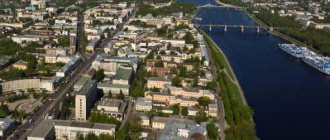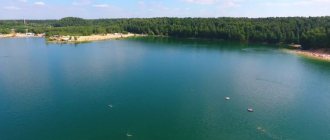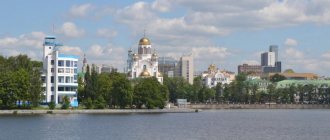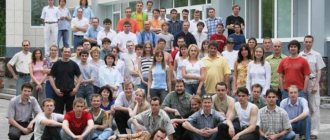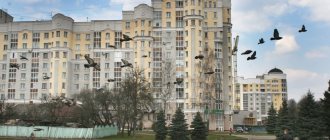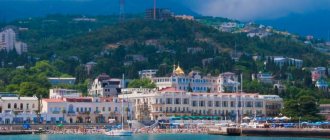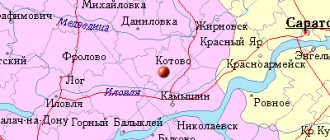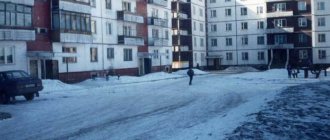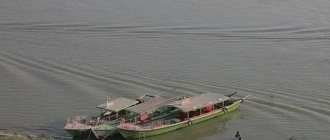Of course, the nearby resorts of Berdyansk and Kirillovka lure travelers with a variety of entertainment. But Primorsk also has something to surprise you with.
1000 kilometers to save Ukraine: roads to seaside resorts were inspected
Primorsk is not very popular among touristsAuthor: Irina Grishchenko
Moreover, against the background of resorts crowded with vacationers, Primorsk stands out for its calm and family vacation, clean and large beaches, shallow and warm sea. However, even ardent adventurers will not be bored. In addition to traditional banana riding, tourists here are offered to try their hand at air surfing.
Calm in PrimorskAuthor: Irina Grishchenko
And don’t forget about the unique natural resources of the region, such as the Obitochnaya Spit and the fantastic Eliseevsky Quarry. But more on all this later.
How to get to Primorsk?
There are no railway tracks in Primorsk, but this is not a problem at all. Neighboring cities - Melitopol and Berdyansk - receive trains from almost all over Ukraine. If it is not possible to get to Berdyansk or Melitopol from your city, then go to Zaporozhye. And from there take the bus and in 3.5 - 4 hours you will be in Primorsk.
How much does the road to Primorsk cost?:
- from Zaporozhye – 190-230 hryvnia;
- from Melitopol – 65-80 hryvnia;
- from Berdyansk – 40-50 hryvnia.
Your own car can be an excellent alternative to the bus. Moreover, in 2022 the P37 highway was repaired and, frankly, it is not inferior to European roads. The route from Zaporozhye with your own car will look something like this:
By car from ZaporozhyeAuthor: Google Maps
Primorsk will live according to house-building. And again Trabera
The population of Primorsk will triple in ten years if Primorsky UPC builds a residential area for 12 thousand. Vice Moskvin believes that they are asking a lot.
The administrations of the Vyborg district of the Leningrad region and the Primorsky urban settlement are recommended to prepare documentation by February 29 for the possible transfer of a land plot with an area of 179.6 hectares to Primorsky UPC LLC for long-term lease. In this area, the builder of a new port with five transshipment complexes plans to build housing for future workers. The minutes of the November meeting of Vice-Governor Mikhail Moskvin with the management of Primorsky UPC and representatives of the regional Vodokanal were published in the public page “Live How You Want in Primorsk.”
As Mikhail Moskvin told 47news, it is impossible to talk about the transfer of land to Primorsky UPC for house construction as a fact. The decision to transfer land cannot yet be made without changes to the General Plan of the Primorsky Settlement, and they have not been seen at Suvorovsky, 67. These changes are meant to be gradual. In addition, the vice-governor noted that, from his point of view, the seaside areas where the investor plans to develop a residential function are very decent. As for the model of construction and sale of apartments, this is for the shareholders of Primorsky UPC. And the main shareholder there, as 47news reported, is Ilya Traber , who needs no introduction.
Deputy director of Primorsky UPC LLC for design, Dmitry Temkin, did not answer 47news’ questions by phone about housing construction, the mechanism for its implementation and investments in the project. The manager explained that in order not to violate trade secrets, the company's management needs to familiarize themselves with them in writing. Afterwards, the answer is possible. Well, it's a mystery.
In theory, new buildings should triple the population of one of the smallest points in the Leningrad region. Thus, in 2022, 13,666 people permanently lived in the territory of the Primorsky urban settlement, and 5,664 in Primorsk itself. According to plans, by 2030 the city will grow with a new microdistrict for 12 thousand residents. Thus, in ten years about 18 thousand will live in Primorsk, and this is already the level of such regional centers as Priozersk and Podporozhye.
The territory for the new microdistrict is planned to be formed from two plots of land located in the north of Primorsk, behind the private sector of Professor Morozov Street, between the Solnechnaya Polyana gardening and the shore of the Gulf of Finland. According to the cadastral extract, these lands are currently permitted to be used for the construction of a shipbuilding complex with a dry dock. The Primorsky UPC terminals themselves should appear south of the city, six kilometers from the Ermilovo railway station.
The first analogy that comes to mind in the case of Primorsk is housing construction in the Lenryba quarter near Ust-Luga, where over two decades a dozen port terminals have appeared. It is in Lenryb that the arrested former head of Yug-2 OJSC has been officially registered for three years in the port of Ust-Luga today, transshipping coal. It is precisely owned by the port builders of the same Primorsky UPK. The implementation of the “city of port workers” project in Ust-Luga implied the construction of housing for 60 thousand people.
Theoretically, 12 thousand residents are a pair of modern residential complexes of 17-19 floors in Murino. There are about two and a half thousand apartments in them, and it is generally accepted that three people live in a family. It can be assumed that this is also the reasoning in the Primorsky Code of Criminal Procedure when they report about 4 thousand new jobs. But the Leningrad Region, which is not adjacent to St. Petersburg, has its own architectural specificity. In the same Ust-Luga they decided to combine different types of development, but the basis was 4-5 storey buildings with a couple of front doors. A typical example of port housing in Lenryb is the Laukkaan Ranta residential complex, which began to be occupied in 2012. The purchase of housing was carried out under various schemes, including mortgage schemes with the support of port terminal construction companies.
At the same time, in connection with Gazprom’s implementation of a gas processing megaplant project near Ust-Luga, another workers’ settlement should appear. First, housing for the builders of the Ruskhimalyansa enterprise - up to 20 thousand of them are expected, and then for 5 thousand workers.
The initiator of the Tikhvin Carriage Works project, the group of Alexander Nesis and partners, also built housing for workers independently. The plant was considered the largest transport engineering construction site in the country. The residential complexes were built by North-West Investment and Housing IST. But in this case we were not talking about a new quarter-semi-city. Several diverse residential complexes have appeared in different microdistricts of Tikhvin.
It was also recommended that “Primorsky UPC” present the concept for the construction of a residential complex in Primorsk at the international festival “Zodchestvo” in Moscow. It takes place annually in October-November. Thus, there are still ten months to roughly outline where exactly the dockers and Telmans are supposed to be housed.
Alexander Kalinin, 47news
The Primorsky UPC project provides for the creation of a marine terminal near Primorsk in the Vyborg district of the Leningrad region. The terminal will consist of five transshipment complexes designed for the transshipment of mineral fertilizers, grain, general, roll-on-roll and container cargo. The volume of investments is estimated at 170 billion rubles. Construction of the first coal terminal is scheduled to be completed in 2022.
According to SPARK Interfax, Primorsky UPC LLC is owned by six individuals. Thus, reputable businessman Ilya Traber owns 28.5%, his partner Ramis Deberdeev - 22.17%, Vladimir Danilenko - 19%, Sergei Pupko and Artyom Begun - 12.67% each, and Andrey Sizov, who is also the general director of the enterprise, - 5%.
Public hearings held in July in the village of Ermilovo showed that local residents do not want the terminal. The negative attitude of the population towards the project is recorded in the minutes of the meeting.
However, the governor of the Leningrad region, Alexander Drozdenko, has repeatedly stated that a new port complex near Primorsk will be built, since the fundamental decision was made at the federal level.
Where to live in Primorsk?
There are many options for renting accommodation, most prices are 400 - 500 hryvnia per person per night. The only and main disadvantage is that the apartment or house that is rented by locals does not always have everything necessary for a comfortable stay. And one more thing: when renting a house from the locals, you shouldn’t count on a balcony overlooking the sea, because the entire coastline is occupied by recreation centers.
There are many recreation centers in Primorsk and they are all built on Kurortnaya Street. This is a long street that stretches along the coastline. The cost of a holiday at the base depends on many factors.
Ukraine. Zaporozhye region
There is a city with the same name in Ukraine, not far from the Krasnodar Territory. Where is this city of Primorsk located? Just 2 km from Azov, in the Zaporozhye region, on the banks of the Obitochnaya River. The town's population is 12,860 people.
Previously, there were Nogai settlements in these places; the first mention of them dates back to 1770. Until 1964, the city was called Nogaisk. Today it is a small resort town. Since Soviet times, children's health camps, the Primorskaya tourist base, and recreation centers have been preserved here. The Odessa – Rostov-on-Don highway passes through the town. There is no railway.
"Motor"
The health complex is located on Kurortnaya street, 29. The well-groomed green area of the complex, with a total area of 12.5 hectares, will help you take your mind off
city bustle. In addition, squirrels and hedgehogs can be found on the territory of the complex. Children will be interested in visiting a large poultry house with pheasants and peacocks, and adults will be interested in going to the gym or sauna. Motor also has a swimming pool with a modern spa complex.
The health complex has several types of rooms. Prices include three meals a day.
- single room with one bed – 1040 hryvnia per person.
- double room with air conditioning – 1450 hryvnia per person.
- double room “Standard” with air conditioning – 1150 hryvnia per person.
- two-room double room “Standard” – 1450 hryvnia per person.
- two-room double room “Junior Lux” – 1650 hryvnia per person.
- double room “Studio” – 1750 hryvnia per person.
- two-room double room “Lux” – 1800 hryvnia per person.
- one-room double room “Lux” – 1800 hryvnia per person.
To get to the beach you need to cross the bridge over the estuary. This will take approximately 15 minutes. The beach is equipped with changing rooms and sun loungers.
"Surf"
The recreation center, which is considered the best in Primorsk, is located on Kurortnaya Street, 81. On the large landscaped territory of Priboy with a total area of 70 thousand square meters there is a beautiful park and rose garden. Every day the animators organize an interesting entertainment program for children. There are also several cafes and a nightclub on the territory of the recreation center. It is interesting that strangers cannot enter the territory of Priboy; the base is completely closed.
The private sandy beach is equipped with shade canopies, sun loungers, and benches. Also at Priboi there is a swimming pool, a children's complex “Little Country”, a beauty center, a zoo corner, a library, a first-aid post, a parking lot, gyms and rental of beach accessories.
Rooms vary by category:
- single “Standard” with air conditioning – 745 hryvnia per person.
- double room “Standard” with air conditioning – 710 hryvnia per person.
- two-room double room “Standard” – 780 hryvnia per person.
- two-room double room “Junior Lux” – 880 hryvnia per person.
- two-room double room “Lux” – 1220 hryvnia per person.
The price includes buffet meals.
Attractions
- Lutheran Church of St. Mary Magdalene (1900-1904, neo-Gothic with Art Nouveau elements). Architect Josef Stenbeck.
- Museum of Local Lore.
- "Bank" ("Glass") is a concrete structure - a pier on which the first Soviet nuclear icebreaker "Lenin" was tested. There is a giant chain on it for mooring this icebreaker.
- The ruins of a Finnish field hospital and the dacha of Mannerheim's girlfriend.
- In Primorsk, a city with a population of about 5 thousand people, there are 8 different religious communities: Orthodox, Lutheran, Peace Community, Church of the Twelve Apostles, etc.
- Monuments to the heroes of the Great Patriotic War, mass graves, memorial military cemetery.
- A picturesque stone pier of Finnish construction.
- A number of sandy beaches with beautiful views.
- On the territory of the city there are a number of picturesque and somewhat curious with their luxury “new Russian” dachas built in the early 1990s (some of them are being destroyed).
"Roadman"
You can enjoy a truly quiet and family vacation at the Dorozhnik boarding house (Kurortnaya Street, 85). The territory of the boarding house also abounds in a variety of trees and flowers, however, at first glance, it is not as modern as the territory of the two previous bases. In 2022, a new swimming pool appeared at Dorozhnik. The beach of the boarding house is relatively small, but has clean sand and wide canopies from the sun. Another big advantage is the absence of an estuary. To get to the beach you will need to walk 100 meters from the building.
Prices for rooms without meals:
- cottage for up to 6 people – 3600 hryvnia.
- single room “Standard” – 480 hryvnia per person.
- double room “Standard” – 690 hryvnia per person.
- two-room double room “Junior Lux” – 1140 hryvnia per person.
- one-room triple room “Lux” – 1470 hryvnia per person.
- two-room triple room “Lux” – 1650 hryvnia per person.
"Boathouse"
The Elling recreation center (29 Kurortnaya Street) has a good beach and a small number of people. Holiday houses are located 20 meters from the sea. The base itself is small and has almost no territory of its own. But it is ideal for a holiday with a small child, because you don’t have to go far to the sea. The entrance to the sea is very convenient, the bottom is perfectly clean, and you have to walk several tens of meters to reach the depth. At the same time, Elling does not have its own canteen with a buffet line, but there is a cafe.
Prices for rooms without meals:
- double room “Lux” – 500 hryvnia per person.
- double room “Lux” (superior comfort) – 650 hryvnia per person.
Leningrad region
Where is Primorsk located in the Leningrad region? Located in the Vyborg region. Until 1948 it was called Koivisto, which means birch in Finnish. Even earlier it was called Birch Island, and this name sounded like Björke in Swedish. The earliest name of the city is Russian - Berezovy. It is located on the shores of the Gulf of Finland. From it to Vyborg - 48, and to St. Petersburg - 75 kilometers.
The town of Primorsk is small, the population is 5739 people, cozy and clean. Life in it proceeds calmly and measuredly. The city has a long and interesting history. Once it was conquered by the Swedes, in 1719 the Russian Emperor Peter I returned it and the city of Vyborg, they became part of Russia. In 1812, after the last Russian-Swedish war, Finland became part of the Russian Empire. The Vyborg province, which included Primorsk, was transferred to the Grand Duchy of Finland, which was part of the empire.
In 1920, Finland gained independence and, together with the territory of the Vyborg province, seceded from Russia. In 1940, after the end of the Finnish War, these territories were returned to the USSR. In 1941-1944 they were under Finnish occupation. In 1944, the territory of the Vyborg region with the city of Koivisto was transferred to the USSR. In 1948 the city received a new name Primorsk.
Its significance in the economy of the Leningrad region is great. This is where the oil pipe ends, and further movement of oil and its products goes by sea. This city has the largest oil loading port. The majority of the city's population is associated with the work of this port.
Where and what to eat in Primorsk?
There are two markets and several supermarkets in Primorsk. There shouldn't be any problems with ATMs, so you don't have to carry a lot of cash with you. However, there are no terminals at the market where you can buy homemade fruits and vegetables, as well as fresh fish.
The central market in Primorsk is located on Parkovaya Street, 84. There you can buy not only food, but also clothing. ATB and other shops are located near the Central Market. The other market is located closer to the sea, about 2.7 kilometers from Central Beach. It is smaller in size but has everything you need. In addition to fruits, vegetables, meat and fish, you can buy inflatable rings and other beach equipment there.
If you don’t want to cook yourself, you can visit the cafe-bar. Probably the most atmospheric place on the seashore is the Oblaka cafe-bar. It is located on Central Beach, to the left of the main entrance. There you can sit on soft ottomans a few meters from the sea, drink cocktails and eat burgers. You can also smoke hookah and watch a movie on a large open-air projector.
Prices in the cafe are quite affordable. For a grilled burger with a portion of potatoes and sauce you need to pay 80-95 hryvnia. Lemonade costs between 30-40 hryvnia. And the cost of an alcoholic cocktail starts from 80 hryvnia.
For burgers and lemonade at Oblaka.primAuthor: Instagram @oblaka_prim
The equally cozy Paradise cafe is located on Slavyanskaya Street, 26. Prices in Paradise will pleasantly surprise you. A salad with squid will cost 65 hryvnia, and Caesar with chicken breast costs the same. The menu also includes soups, meat dishes, desserts and hot drinks.
Squid salad at ParadiseAuthor: Instagram @paradise_cafe_prymorsk
Story
The first mention of the settlement of Björkö in Russian sources dates back to 1134. As Berezovskoye it appears already in chronicles dating back to 1268. Since the time of Yaroslav the Wise and his wife, the Swedish princess Ingegerda, this territory was under the influence of both Sweden and the Novgorod land, and after 1478 and the Moscow principality, although according to the Orekhovsky peace of 1323 this territory went to Sweden, the name of the settlement from then on became Björkö (Swedish: Björkö). This was not refuted by the Tyavzin Peace Treaty of 1595 or the Stolbovo Peace Treaty of 1617.
Russia
In 1719, Peter I annexed the lands conquered in the west, including Vyborg, to Russia. Administratively, the new territories became part of the St. Petersburg province as the Vyborg province. At the same time, in 1719, a decree was issued on the establishment of a guard on Bolshoy Berezovy Island. In 1721, the Northern War ended with the Treaty of Nystadt, according to which Sweden transferred this territory to Russia. In 1722, a pilot service was organized here from Vyborg to the Birch Islands.
In 1744, after another Russian-Swedish war, the Vyborg province was created, where the Vyborg province was assigned.
After the Russian-Swedish “Finnish” war in 1809, according to the Treaty of Fredericksburg, Russia received from Sweden all of Finland, the Åland Islands and the eastern part of Ostrobothnia (Pohjanmaa) to the rivers Torneo and Muonio, into the “eternal” possession of the Russian Empire. The newly conquered region passed under the Friedrichsham Peace Treaty “into the property and sovereign possession of the Russian Empire” as the Grand Duchy of Finland. In 1812, the Vyborg province became part of the Grand Duchy of Finland as part of the Russian Empire.
In 1905, Tsar Nicholas II and his large retinue visited Bjorko (Koivisto). From the diary of Nicholas II (1890-1906):
September 14th. Wednesday. At 2 o'clock we left Tranzund and went to Bjorke. We anchored between Kaivitsa and Ravica with our entire detachment... September 16th. Friday. We got up early. At 10 o'clock I went to the destroyer "Threatening", which weighed anchor and went to the exit to the sea. We flew to Rondo Island and returned to the anchorage in an hour and 5 minutes. September 17th. Saturday. We went ashore and visited the kirk in Koivisto, it was recently built, all of stone, instead of the previous one, wooden. I also looked around the sawmill.
On July 11 (24), 1905, the Björk Treaty was signed nearby by Nicholas II and Wilhelm II.
With the beginning of World War I, the Russian military department decided to build a railway line from Terijoki (Zelenogorsk) to Koivisto (Primorsk).
Finland
Until 1918, Berezovoye was part of the Vyborg province, then, according to the results of the Tartu Peace Treaty of 1920, the settlement seceded from Russia and until the Moscow Peace Treaty of March 12, 1940, was part of Finland, and the settlement of Berezovoye then received the name Koivisto (Finnish). Koivisto).
USSR
After the Winter War, according to the Moscow Peace Treaty, the city was annexed to the USSR and became part of the Karelo-Finnish SSR. During the Soviet-Finnish War (1941-1944), the city was occupied by Finnish troops from September 2, 1941 to June 18, 1944. The Moscow Armistice in 1944 and the Paris Peace Treaty between the USSR and Finland (1947), according to which the border on the Karelian Isthmus returned to the border established by the Moscow Peace Treaty of 1940 finally confirmed the ownership of Primorsk.
On October 1, 1948, the city was renamed Primorsk.
According to 1990 data, the village of Krasny Ostrov was also administratively subordinate to the Primorsky City Council.
Where to swim in Primorsk?
A popular place among locals is Central Beach. It houses several attractions and sea slides. However, the sand on the beach is not cleaned. The entrance to the sea is very uncomfortable - in some areas there is clay at the bottom instead of sand, and in some places there are stones.
Wild beaches are difficult to accessAuthor: Irina Grishchenko
In addition, the Central Beach is equipped with only a few canopies, and there are no sun loungers at all. There is no centralized sewage system on the beach, so the toilets are very dirty and are not intended for tourists.
In short, it is better to visit the beaches of Dorozhnik and Elling. There the distance to the sea is minimal. In addition, the beaches have canopies and sun loungers; their prices start from 100 hryvnia per day.
You can get to the beach by your own car, taxi or public transport. Buses and minibuses in Primorsk run every half hour, but only from 7:30 to 18:00.
How to have fun?
In addition to traditional beach holidays, in Primorsk you can try your hand at air surfing. The exercises take place on an estuary with a hard bottom, where the maximum depth reaches one meter. Therefore, the classes are completely safe.
Kitesurfing and windsurfing have common features, but in the first case a person rides on a board with a sail, and in the second - on a board to which a large kite is attached. Kitesurfing is easier to learn. With the help of a skilled instructor, this can take several hours. With windsurfing things are a little more difficult. In order to master windsurfing, you need extraordinary endurance and several days of training. Accordingly, prices for entertainment differ:
- kitesurfing – from 600 hryvnia per hour;
- windsurfing – from 1000 hryvnia per hour.
Try windsurfing in PrimorskAuthor: photo from facebook.com/azovkite/
Where to go?
A must see place in Primorsk is Kosa Obitochnaya. It is considered one of the 100 wonders of Ukraine and this is not without reason. On more than eight thousand hectares you can find almost 100 species of birds and more than 30 species of animals. The coastline is quite flat and clean, so even children will be comfortable swimming there in good weather, however, this is what makes the Sea of Azov different.
Spit InhabitedAuthor: Alexey Novik
Another fantastic place is the Eliseevsky Quarry. It is only 40 kilometers away from Primorsk. But the views are worth every minute of the journey. It is also called the Green Grave for the variety of greens and blues in the water. The quarry consists of two pits connected to each other by a rock lintel. They are filled with crystal water. The depth of the lakes reaches from 18 to 24 meters, so tourists in search of new emotions often jump down from the cliffs. The quarry contains more than 150 rocks and minerals that existed on our Earth billions of years ago. Even if you don’t want to swim, you still need to see the quarry.
Eliseevsky quarryAuthor: Amazing Ukraine
Unfortunately, you can only get to the Eliseevsky quarry and the Obitochnaya Spit with your own car. But locals sometimes organize mini trips to these unique places. For example, you can place advertisements on the Facebook page of the community “Primorsk is Ukraine” and, if you’re lucky, you can find fellow travelers.
If luck doesn’t smile on you, but you want to see the quarry, then you can try to get there on foot. You need to take a bus to the outskirts of Eliseevka. The landmark is a well, near which there is a road fork. After this, you will need to walk along a dirt road for several minutes. Already at the first slope of the quarry, you will notice two roads, each of which leads to “its own” pit. Before the trip, it is recommended to study the upcoming route in detail, including walking.
History of the city of Primorsk
Content:
Primorsk is located just 75 kilometers west of St. Petersburg. And, if you count directly, then the modern border of Finland from here is no more than 50 versts. It is no coincidence that the location of the settlement determined its repeated change of subordination to several countries. And also several of its renamings.
The settlement received city status in 1940. Still part of Finland. And the city began to be called “Primorsk” in 1948. Already located within the borders of the USSR. Before its current name, the settlement was called “Koivisto”. What does it mean (literal translation from Finnish) - Berezovoe, Berezovskoe (Finnish Koivisto , from koivu, birch )
Previously, until 1918, Berezovoye was assigned to the Vyborg province, then, according to the results of the Tartu Peace Treaty of 1920, the settlement seceded from Russia and until the Moscow Peace Treaty of March 12, 1940, was part of Finland, and the settlement of Berezovoye then received the name Koivisto ( Finnish Koivisto ).
Primorsk traces its ancestry back to ancient times.
So, Berezovsky was mentioned back in 1268. The surrounding lands more than once came under the sphere of influence of either Sweden or the Novgorod and Moscow (later) principalities. But even the Stolbovsky Peace Treaty assigned Berezovskoe to Sweden. (The Stolbovo Treaty of 1617 put an end to the Russian-Swedish war (1610-17), but completely decided Russia’s access to the Baltic Sea)
It is no coincidence that for many years the settlement was called in the Swedish manner - Björkö (Swedish: Björkö - birch island )
Only under Peter I, after the victory over the Swedes in the Northern War (1700 -1721) and the Russian-Swedish War of 1744 (under Elizaveta Petrovna), the Vyborg province was formed on the lands conquered from Sweden. Which included Bjorke - Berezovskoye.
After the next Russian-Swedish “Finnish” war, in 1809 the entire territory of present-day Finland was included in the Russian Empire as an “eternal possession”. So, in any case, it was spelled out under the Friedrichsham Peace Treaty. With the signing of this document, Finland for the first time in history acquired the form of statehood, being part of Russia as the Grand Duchy of Finland. And Berezovskoye became part of the administrative entity “Vyborg Province”.
Further, the history of Berezovsky as a Russian settlement continues until 1918. And after Finland left the young Soviet state (Soviet Russia), renamed Koivisto, it became part of Finnish territory.
Primorsk Embankment near the Gulf of Finland. Leningrad region
After the Winter War of 1939-40. – The USSR expanded its northern borders. And Koivisto again returns to Russian jurisdiction. For the short war years of the Great Patriotic War (from 41 to 44), it again became a Finnish settlement.
And only with the end of the Second World War and to this day, Koivisto, renamed Primorsk, finally becomes ours, Russian.
Primorsk in our time
It is worth noting that until recently this city belonged to the so-called “closed” settlements. The proximity to the Finnish border, as well as the location of the Energia testing site here, were the reasons why a “passport regime” was required to visit Primorsk. An outsider could only enter the city by following the necessary procedures.
Since 1987, the “closure” of the city has been lifted and, therefore, anyone can freely visit it in our time.
Do not think that in this small cozy town (about 5.5 thousand inhabitants) of all the “attractions” there is a major port for transshipment of oil and petroleum products in the North-West region of Russia. Here is the very end point of the Baltic Pipeline System. And it is with this oil pumping terminal that the name of the city most often appears in official news.
There is, perhaps, the most famous object in Primorsk, which does not often make it to the headlines of news reports.
What to see in Primorsk. "Lenin" and glass ("jar")
“Glass” (“can”) in Primorsk
It was no coincidence that I wrote the surname of the leader of the world revolution in quotation marks. Since Ilyich was not directly connected with the history of the city of Primorsk. But over time, his name made one of the city’s objects perhaps the most famous landmark of this settlement. And besides, this attraction is one of the most unusual memorable places associated with our Russian, Soviet history. With the achievements of our science and the development of navigation. But first things first.
I think the reader knows that the very first nuclear icebreaker in the world was designed and built in the Soviet Union. And he was called “Lenin”. By the way, the only country in the world that currently has a nuclear icebreaker fleet is Russia. The legal successor of the USSR in the development of the North and the Northern Sea Route.
The world's first nuclear-powered icebreaker, Lenin, was launched in 1957. From the stocks of the Leningrad Admiralty Shipyards. Former shipyard named after. Andre Marty. And to test the nuclear power plant, the icebreaker was sent to Primorsk. (I’ll tell you about the icebreaker “Lenin” in more detail. In a separate article. I’ve been on board the nuclear-powered icebreaker).
The Gulf of Finland is shallow. It’s not for nothing that it (part of the Neva Bay, and the entire bay) is called the “Marquise Puddle”. However, this name is connected not only with the depths. It would not have been possible here without a real marquis. This nobleman's name was Ivan Ivanovich de Traverse.
Jean-Baptiste Prévost de Sansac, Marquis de Traversé
Jean-Baptiste Prévost de Sansac, Marquis de Traversé
Traverse - Russian naval commander, admiral of the Russian Fleet, Minister of the Navy of Russia in 1811-1828. French by birth. He became famous, among other things, for the fact that under him, long-distance sea voyages almost ceased, and the fleet’s voyages were carried out no further than Kronstadt (in the Baltic). The former commander of the Russian rowing fleet believed that the shallow depths and closed nature of the Neva Bay were necessary conditions for combat training. And besides, under Traverse, government funding for the Russian fleet was reduced. Which also did not contribute to long trips. However, this not very favorable period for the Russian fleet did not last long. But it was enough to give popular rumor a somewhat derogatory name for the Gulf of Finland - “Marquis’s Puddle”.
Pier (pier) "Lenin"
The nuclear-powered icebreaker "Lenin" was sent to Primorsk to test its power engine. In order to experimentally find out how many horsepower the icebreaker engine can develop. And will the design power correspond to the actual power of the ship’s power plant?
To measure a physical quantity, the most reliable and simplest method was chosen. For which it was necessary to securely fasten (moor) the nuclear-powered icebreaker to something and accelerate the power unit to maximum power. Having given full speed, use a giant dynamometer and measure the tractive force of the icebreaker's propulsion system. At the very moment when the ship reaches the peak power of the power plant, trying to break away from the pier.
It was no coincidence that Primorsk was chosen for such a test. Here, off the coast of the city, is one of the few places in the Gulf of Finland where the depths are decent. And, what is very important, the large depth difference begins very close to the coastline.
The glass-bank in Primorsk is that pier near the shore. To which the nuclear-powered icebreaker was moored. The pier is of a peculiar shape. In the form of a giant tube. To ensure reliable mooring of the nuclear-powered ship, its stern was secured to the powerful bollard of the pier with a giant chain. Part of the links, which for a long time caused delight and surprise among everyone who visited this “jar-glass”. Since the entire chain was not dismantled after testing
I found myself in Primorsk and went to inspect this unusual “glass”. Which, as numerous sources testified, is still in good condition. And free to visit. So…
Where is the pier (berth) “glass” in Primorsk. Photo and description of the object
I was able to find the location of this iconic pier without difficulty. The pier of the icebreaker "Lenin" is located on the very outskirts of Primorsk. Where the Manola recreation center is located. Entrance to the sanatorium is free. And I, walking past the new and old buildings of the base (and previously there was a sanatorium of the Admiralty Shipyards) - I went out to the shore of the bay.
Primorsk Lenin berth. Glass - jar
The “glass” was already visible on the descent to the shore. The powerful steel structure with a ladder to the pier itself looked impressive. Rocky shores, harsh cloudy skies and the leaden color of the Baltic water emphasized the power of the man-made structure. And the small figurine of a fisherman on the pier ramp (by the way, as it turned out later, it was a woman) well conveyed the scale of the structure. I would like to note that the surrounding landscapes are beautiful. And they are very reminiscent of the nature of Karelia and the North.
Fisherman on the pier
Pier steel structure
Surrounding landscapes:
The Gulf of Finland. Scenery
The Gulf of Finland. Scenery
Townspeople and visiting tourists come here to the pier and to the shore of the bay. Here, away from the city, the places are quiet. Taking a walk along the coast is a pleasure.
As usual, I didn’t try to talk to the locals. I met a city dweller. Who, having learned that I was a visitor, enthusiastically began to tell me about the pier:
Fascinating dialogues
After talking and wishing all the best to my counterpart, I went to the pier. Explore it and the surrounding area. Take a look at that legendary chain. Which the icebreaker "Lenin" was moored to the "glass".
View from the pier and the legendary chain
Climbing onto the metal gangway that leads to the “glass” itself, I saw a clear confirmation of the specifics of the local underwater terrain. The sharp difference in depth is clearly visible. A narrow transparent strip of water - only about two or three meters from the shore. Further, from this boundary, the water surface sharply changes its hue. It becomes lead-colored and there is no talk of any transparency. Here the bottom topography goes sharply into depth.
Rocky bottom of the Gulf of Finland near Primorsk
The berth area is concrete. Three bollards are cast into the concrete. One of which is larger in size. The chain was chained to this bollard. Alas and ah... the chain is no longer here! It's a pity of course. Now photos of its links are in old reports that were here earlier.
The largest bollard. The icebreaker "Lenin" was moored to it with a chain.
Primorsk The largest bollard. "Glass" in Primorsk. There are no chains on it now
The largest bollard. "Glass" in Primorsk
As I learned, a major overhaul of the pier was carried out in 2018. It's been updated. O was dressed in a new protective steel casing. 16 meters in diameter.
The icebreaker Lenin, of course, was not the only ship that was tested at this pier. And not the only icebreaker. So, for example, just after the pier was repaired in 2018, the Andrei Vilkitsky diesel-electric ship tested its power units here.
It is possible that after these tests the chain was dismantled...
While examining the water area near the “glass” I noticed the cages of a fish farm. Which were visible in the distance near the coastline.
Looking ahead, I will say that near these cages I witnessed a funny action. I'll tell you about it below.
Fish farm cage
After examining the legendary “glass” I went for a walk along the shore.
The berth of the icebreaker “O Lenin” (“glass”) is located here:
Berth of the icebreaker LeninAttraction in St. Petersburg and the Leningrad region
Coastline near the “glass” and fish farm
From the glass pier there is a dirt path along the shore of the Gulf of Finland. The local landscape is almost Karelian - a mixture of coniferous and broad-leaved vegetation. It was not for nothing that Primorsk was once called “Berezovsky”. Among the stone boulders and moss trees there are birch trees.
Coastal landscape near Manola
Path along the coast
Along the path are neat old wooden houses. (More like private resorts than service-owned resorts)
Old wooden houses near the "glass"
The houses are located at a distance from each other. The adjacent areas are not fenced. And the quiet, resort atmosphere that reigns in the area does not bring the feeling of village life. Despite a certain desolation, the local inhabitants still appeared to me. For example, these funny guys:
Kittens. Primorsk
And next to me, at the porch of the house, sitting on a stone, an adult cat was carefully watching me. Apparently, the mother of these funny boys:
Cat
However, I also met other inhabitants of these places:
Girl with a scooter
Walking along the shore, I soon saw a group of people. Those gathered together and carefully peered towards the waters of the bay.
Curiosity was stronger than me. And I decided to find out what caused such interest on the part of a group of comrades.
Group of townspeople
As I got closer, I realized what was the matter.
Fish farm
As it turned out, those gathered were watching the release of fish into the fish farm’s cage. And this event was at its very beginning. And it was of some interest to local residents. However, I also became curious to watch this.
Primorsk Fish farm cage
The release of the fish (it looked like it was trout) was carried out simply and unpretentiously. From the special vehicle in which the brought fish was located, the fish were released into the cage through a large-diameter plastic pipe. Fortunately, the height of the shore here is several meters from the water's edge. And the fish, almost “under their own power,” rolled out of the open boxes of the fish carrier. The fish farmers only helped the flexible plastic pipe with the fish rolling along it into the cage not to bend at a sharp bend.
Release of trout into the cage
Release of trout into the cage
Trout farm
So, in general, without any big problems for the trout, it found its new habitat.
Fish farm
After watching the “migration” of red fish, I headed to my car. My plans were to get to know the city of Primorsk itself.
